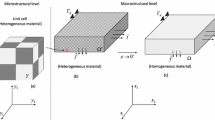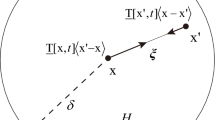Abstract
This study demonstrates a homogenization approach via a modified state-based peridynamic (PD) method to predict the effective elastic properties of composite materials with periodic microstructure. The procedure of modeling the PD unit cell (UC) of continuous fiber-reinforced composite is presented. Periodic boundary conditions are derived and implemented through the Lagrange multiplier method. A matrix-dominated approach for modeling the interphase properties between dissimilar materials is proposed. The periodicity and continuity assumptions are employed to determine the stress and strain fields, as well as the effective elastic properties. The PD-UCs of square and hexagonal packs as well as the 0/90 laminate microstructure are modeled and compared with the analytical, numerical and experimental results from the literature. Good agreement of predicted effective properties can be observed. Unlike other PD homogenization approaches, the effective material properties can be directly and individually obtained from simple loading conditions.






Similar content being viewed by others
References
Gibson RF. Principles of composite material mechanics. Boca Raton: CRC Press; 2016.
**a Z, Zhang Y, Ellyin F. A unified periodical boundary conditions for representative volume elements of composites and applications. Int J Solids Struct. 2003;40(8):1907–21. https://doi.org/10.1016/S0020-7683(03)00024-6.
Suquet PM. Elements of homogenization theory for inelastic solid mechanics. Homogenization Tech Compos Med. 1987;272:193–279.
Aboudi J. Mechanics of composites: a unified micromechanical approach; 1991.
Paley M, Aboudi J. Micromechanical analysis of composites by the generalized cells model. Mech Mater. 1992;14(2):127–39. https://doi.org/10.1016/0167-6636(92)90010-B.
Williams TO. A two-dimensional, higher-order, elasticity-based micromechanics model. Int J Solids Struct. 2005;42(3–4):971–1007. https://doi.org/10.1016/j.ijsolstr.2004.06.057.
Yu W, Tang T. Variational asymptotic method for unit cell homogenization of periodically heterogeneous materials. Int J Solids Struct. 2007;44(11–12):3738–55. https://doi.org/10.1016/j.ijsolstr.2006.10.020.
Silling SA. Reformulation of elasticity theory for discontinuities and long-range forces. J Mech Phys Solids. 2000;48(1):175–209. https://doi.org/10.1016/S0022-5096(99)00029-0.
Madenci E, Barut A, Phan N, editors. Peridynamic unit cell homogenization. 58th AIAA/ASCE/AHS/ASC Structures, Structural Dynamics, and Materials Conference; 2017; Grapevine, TX, United states: American Institute of Aeronautics and Astronautics Inc, AIAA.
Madenci E, Barut A, Phan N. Peridynamic unit cell homogenization for thermoelastic properties of heterogenous microstructures with defects. Compos Struct. 2018;188:104–15. https://doi.org/10.1016/j.compstruct.2018.01.009.
Madenci E, Yaghoobi A, Barut A, Phan N. Peridynamic unit cell for effective properties of complex microstructures with and without defects. Theor Appl Fract Mech. 2020;110:102835. https://doi.org/10.1016/j.tafmec.2020.102835.
**a W, Oterkus E, Oterkus S. Peridynamic modelling of periodic microstructured materials. Proc Struct Integrity. 2020;28:820–8. https://doi.org/10.1016/j.prostr.2020.10.096.
**a W, Galadima Y, Oterkus E, Oterkus S. Representative volume element homogenization of a composite material by using bond-based peridynamics. J Compos Biodegrad Polym. 2019;7:51–6. https://doi.org/10.12974/2311-8717.2019.07.7.
Diyaroglu C, Madenci E, Phan N. Peridynamic homogenization of microstructures with orthotropic constituents in a finite element framework. Compos Struct. 2019;227:111334. https://doi.org/10.1016/j.compstruct.2019.111334.
Diyaroglu C, Madenci E, Stewart RJ, Zoubi SS. Combined peridynamic and finite element analyses for failure prediction in periodic and partially periodic perforated structures. Compos Struct. 2019;229:111481. https://doi.org/10.1016/j.compstruct.2019.111481.
Jenabidehkordi A, Abadi R, Rabczuk T. Computational modeling of meso-scale fracture in polymer matrix composites employing peridynamics. Compos Struct. 2020;253:112740. https://doi.org/10.1016/j.compstruct.2020.112740.
Hu YL, Madenci E. Bond-based peridynamic modeling of composite laminates with arbitrary fiber orientation and stacking sequence. Compos Struct. 2016;153:139–75. https://doi.org/10.1016/j.compstruct.2016.05.063.
Hu YL, Yu Y, Madenci E. Peridynamic modeling of composite laminates with material coupling and transverse shear deformation. Compos Struct. 2020;253:112760. https://doi.org/10.1016/j.compstruct.2020.112760.
Sun CT, Vaidya RS. Prediction of composite properties from a representative volume element. Compos Sci Technol. 1996;56(2):171–9. https://doi.org/10.1016/0266-3538(95)00141-7.
Aboudi J, Pindera M-J, Arnold S. Linear thermoelastic higher-order theory for periodic multiphase materials. J Appl Mech. 2001. https://doi.org/10.1115/1.1381005.
Kamarul A, Kamarudin AEI. Periodic Boundary Condition Technique on Carbon Fibre Composites. In International Conference on Materials Physics and Mechanics 2017.
Qian Y, Swanson SR. Experimental measurement of impact response in carbon/epoxy plates. AIAA J. 1990;28(6):1069–74. https://doi.org/10.2514/3.25168.
Lee H-J, Saravanos DA. The effect of temperature dependent material properties on the response of piezoelectric composite materials. J Intell Mater Syst Struct. 1998;9(7):503–8. https://doi.org/10.1177/1045389X9800900702.
Sertse HM, Goodsell J, Ritchey AJ, Pipes RB, Yu W. Challenge problems for the benchmarking of micromechanics analysis: level I initial results. J Compos Mater. 2018;52(1):61–80. https://doi.org/10.1177/0021998317702437.
Author information
Authors and Affiliations
Corresponding author
Ethics declarations
Funding
This work is supported by the National Natural Science Foundation of China under Grant Nos.11902197 and 11972234 and is sponsored by Shanghai Sailing Program under Contract No.19YF1421700.
Rights and permissions
About this article
Cite this article
Li, X., Yu, Y., Mu, Z. et al. Meso-Scale Modeling for Effective Properties in Continuous Fiber-Reinforced Composites by State-Based Peridynamics. Acta Mech. Solida Sin. 34, 729–742 (2021). https://doi.org/10.1007/s10338-021-00239-7
Received:
Revised:
Accepted:
Published:
Issue Date:
DOI: https://doi.org/10.1007/s10338-021-00239-7




